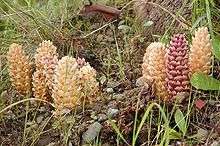Boschniakia
| Boschniakia | |
|---|---|
 | |
| Boschniakia hookeri | |
| Scientific classification | |
| Kingdom: | Plantae |
| (unranked): | Angiosperms |
| (unranked): | Eudicots |
| (unranked): | Asterids |
| Order: | Lamiales |
| Family: | Orobanchaceae |
| Genus: | Boschniakia C. A. Mey. ex Bong. |
| Species | |
|
3: see text | |
Boschniakia is a small genus of three species of parasitic plant in the broomrape family. They are known commonly as groundcones and they are native to western North America and extreme northeastern Asia.
Groundcones are holoparasitic, meaning they depend entirely on a host plant for nutrients and contain little or no chlorophyll. These plants often parasitize alders but they are found on many other plants. B. hookeri may be found on salal and huckleberries, and B. strobilacea grows on manzanita and madrone. Groundcones often look at first glance like pine cones lying on the ground, especially when they are brown in color. They may also be shades of yellow, red, and purple. Each plant may be a few inches tall, and pine-cone-shaped or cylindrical. The plant above ground is almost entirely made up of its inflorescence, a tightly packed column of thick cup-shaped flowers. The groundcone produces haustoria which penetrate the roots of its host and provide it with water and nutrients.
Species:
- Boschniakia hookeri - Vancouver groundcone, small groundcone
- Boschniakia rossica - northern groundcone, cao cong rong
- Boschniakia strobilacea - California groundcone
External links
- Jepson Manual Treatment
- USDA Plants Profile
 Data related to Boschniakia at Wikispecies
Data related to Boschniakia at Wikispecies